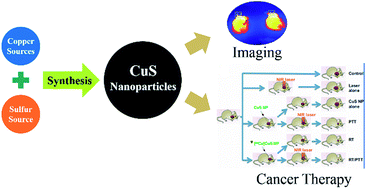Synthetic methods of CuS nanoparticles and their applications for imaging and cancer therapy
Abstract
As a single-compartment theranostic nanosystem, copper sulfide nanoparticles have received much attention as they can be used to visualize and treat tumours simultaneously. In this paper, a comprehensive survey of the basic concepts and up-to-date literature results concerning the potential use of CuS nanoparticles for biomedicine applications is presented. The first part summarizes various methods developed to synthesize CuS with varied morphologies and structures, including nanospheres, nanocages, nanoplates, nanotubes, nanorods and nanowires. Then the prepared nanoparticles with designed structures and properties are further explored for their applications in both photoacoustic imaging and cancer therapy. The advancements in photothermal therapy, combinatorial therapy and drug delivery are discussed in detail.


 Please wait while we load your content...
Please wait while we load your content...